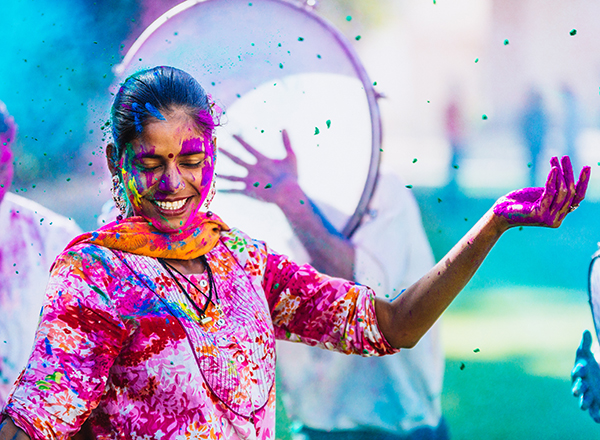Holi, the Hindu Festival of Colors

This message is one of many related to our diverse community’s numerous unique holidays, including cultural, historic, and religious observances throughout the year. I am likely to write about the holidays or cultural observances that mean the most to you as they occur throughout the year. Please let me know if you want to learn my plans about a holiday that is specifically important to you.
On Monday, March 6 to Tuesday, March 7, many of the world’s Hindus, South Asians, and their communities will celebrate the festival of Holi.
What is Holi?
Holi is a joyous and colorful holiday. It is one of the two most important festivals of the Hindu year (the other is Diwali).
The holiday dates back to the fourth century A.D. It commemorates the return of spring after a long winter and also symbolizes good triumphing over evil. The holiday falls on Purnima, the Sanskrit word for full moon, and occurs during the Hindu calendar month of Phalguna.
The origin story of the holiday varies, but all the stories are grounded in the ideas of love, goodness, and renewal. Some variants are based on the story of Hiranyakashipu, a king who believed he was immortal, and his son, Prahlad. Prahlad was a devoted worshipper of Lord Vishnu. Hiranyakashipu was offended that his own son would worship Vishnu instead of him. One story says Hiranyakashipu asked Prahlad’s aunt to burn him in a fire, but the boy was protected by Vishnu and remained unharmed. In another variant, Vishnu appeared in the form of a half-lion, half-man and killed Hiranyakashipu.
Another story centers on the deity Lord Krishna as a child. He is said to have used bright colors as a fun way to liven up the faces of his friend Radha and others.
The name of the holiday also has different origin stories. In one story, the name comes from a process in which gram (chickpea flour), wheat, and other grains are roasted. This mixture of grains is called “holuk,” leading to the name Holi. In a different story, Holi comes from the Hindi word “hola,” which means offering sacrifices or prayer to give thanks for the harvest.
Celebrations and observances
The night before the festival opens is called “Chhoti Holi,” or “little Holi.” Bonfires are ignited in some communities to symbolize the burning of evil spirits. Community members participate by adding wood, twigs, and leaves to the flames while dancing or socializing around the fires. Some communities roast grains and corn to share and promote community connections.
In some communities, the streets, parks, and public spaces are transformed into a panorama of colors as people throw colored powder (gulal) or colored water (pani) into the air and cover themselves and others with the colors, often while dancing and singing to festive music. In some cases, water sprayers are used to add to the spread of colors, or water balloons are dropped from rooftops.
Some of the individual colors have specific meanings:
- Blue symbolizes Krishna, a Hindu deity often portrayed with blue skin.
- Green symbolizes rebirth and new beginnings.
- Red symbolizes marriage or fertility.
- Yellow is the color of turmeric, the main spice in curry and a substance considered to have medicinal properties.
Hindu temples are decorated with bright colors, and the deities are decorated with bright clothing and jewels. Holi ceremonies are held in temples and cultural centers to honor three of the Hindu deities: Lord Vishnu, Lord Krishna, and the Goddess Radha.
Families often gather for festive meals after the public celebrations. Sweets and desserts are shared with family and friends. Children receive new toys and gifts. This year’s celebrations will be affected by the pandemic, as it remains unsafe to gather in large numbers. But the spirit of joy and celebration remains.
To all who celebrate: Happy Holi!
Russ Kavalhuna
President
president@hfcc.edu